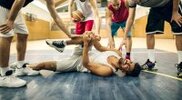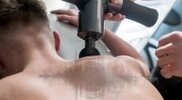V
vkim
Guest
If you’re an athlete, chances are you’ve encountered an injury or two. Whether it be a simple, two-day bout of severe DOMS or a full-blown hamstring tear, chances are, you’ve had to recover at home.
The stress that floods in after a twisted ankle or tweaked muscle is normal, but there is no need to panic. Although it’s always recommended to visit a physical therapist when pain lasts longer than you expect, sometimes it’s not easy to grab an appointment (for many reasons). The good news is, there are things you can do to recover at home that will help speed up recovery and relax your mind; no matter the injury.
Here are some top tips from a respected physical therapist on how to treat your injuries and recover at home.

Workout Tips
Here are training pitfalls you need to avoid when hitting the iron.
Read article
The most common injury athletes encounter Injuries happen, especially to athletes, and the most common to take place is a strain. Cord DeMoss PT, DPT, CSCS, and co-owner of Vitality Therapy and Performance in Tulsa, OK, explains the most common injury he sees his athletes encounter is a muscle strain. “This is when a person has an acute over-stretching of the muscle, usually while under tension, that causes a few of the muscle fibers to tear within the belly of the muscle,” says DeMoss, which is most common in the hamstrings, quads, and upper or lower back.
Although there can be some confusion as to the difference between a strain and a sprain, the difference is quite drastic. “A strain is typically lay terms for being associated with tearing of a muscle fiber, or muscle-tendon; A sprain is in a ligament that connects two bones together,” says DeMoss. The best way to determine whether your injury is a strain or a sprain is to meet with a physical therapist or doctor and move forward with the best healing treatment.

skynesher / Getty
First things first — don’t fear: “Athletes tend to have the most fear associated with upper or lower back injuries,” DeMoss explains. “Taking a moment to assess the situation is key and can help to calm anxiety, especially if the strain is back related. When unsure, a physical therapist can help you assess, but, if you cannot get into a PT right away here’s what not to do: Stretch deeply.
Many times, when an injury occurs, stretching is thought to be the first thing to do. However, it can cause further damage. “If we have just caused small tearing due to an overstretch moment, we do not want to add stretch to that area.”

Microgen / Shutterstock
DeMoss feels the RICE (Rest, Ice, Compression, Elevation) principle has been largely overblown, but feels it does play an important role when used immediately after an injury. “Icing the injury for the first day or two can help, especially when combined with non-strenuous movement to promote blood flow, but after that, there isn’t much of a healing effect of ice,” he says. “It is at this point that heat and gentle exercise work best.”
In short, ice can help to slow down the inflammation from the immediate injury, but after that period is over, you want to encourage the muscle to work lightly in order to stimulate growth.
At this point (after the assessing and icing is done), you might be wondering where recovery gadgets that flood the internet come in; here is when to use them and when to avoid them.

Cool Hand Creative / Shutterstock
Regarding what gadgets to use post-injury, DeMoss says it’s really hard to make a blanket statement there because it does truly depend on the stage of healing. intensity, and location. “None of the gadgets should cause pain especially immediately following an injury,” says DeMoss when moving forward with recovery gadgets.

izusek / Getty

Workout Tips
Your guide to dealing with common injuries so you can get back to the gym ASAP.
Read article
Continue reading...
The stress that floods in after a twisted ankle or tweaked muscle is normal, but there is no need to panic. Although it’s always recommended to visit a physical therapist when pain lasts longer than you expect, sometimes it’s not easy to grab an appointment (for many reasons). The good news is, there are things you can do to recover at home that will help speed up recovery and relax your mind; no matter the injury.
Here are some top tips from a respected physical therapist on how to treat your injuries and recover at home.

Workout Tips
Top 10 Ways to Avoid Injury
Here are training pitfalls you need to avoid when hitting the iron.
Read article
The most common athletic injuries
The most common injury athletes encounter Injuries happen, especially to athletes, and the most common to take place is a strain. Cord DeMoss PT, DPT, CSCS, and co-owner of Vitality Therapy and Performance in Tulsa, OK, explains the most common injury he sees his athletes encounter is a muscle strain. “This is when a person has an acute over-stretching of the muscle, usually while under tension, that causes a few of the muscle fibers to tear within the belly of the muscle,” says DeMoss, which is most common in the hamstrings, quads, and upper or lower back.
Although there can be some confusion as to the difference between a strain and a sprain, the difference is quite drastic. “A strain is typically lay terms for being associated with tearing of a muscle fiber, or muscle-tendon; A sprain is in a ligament that connects two bones together,” says DeMoss. The best way to determine whether your injury is a strain or a sprain is to meet with a physical therapist or doctor and move forward with the best healing treatment.

skynesher / Getty
Hurting? Do this first!
First things first — don’t fear: “Athletes tend to have the most fear associated with upper or lower back injuries,” DeMoss explains. “Taking a moment to assess the situation is key and can help to calm anxiety, especially if the strain is back related. When unsure, a physical therapist can help you assess, but, if you cannot get into a PT right away here’s what not to do: Stretch deeply.
Many times, when an injury occurs, stretching is thought to be the first thing to do. However, it can cause further damage. “If we have just caused small tearing due to an overstretch moment, we do not want to add stretch to that area.”

Microgen / Shutterstock
Ice it … or not
DeMoss feels the RICE (Rest, Ice, Compression, Elevation) principle has been largely overblown, but feels it does play an important role when used immediately after an injury. “Icing the injury for the first day or two can help, especially when combined with non-strenuous movement to promote blood flow, but after that, there isn’t much of a healing effect of ice,” he says. “It is at this point that heat and gentle exercise work best.”
In short, ice can help to slow down the inflammation from the immediate injury, but after that period is over, you want to encourage the muscle to work lightly in order to stimulate growth.
At this point (after the assessing and icing is done), you might be wondering where recovery gadgets that flood the internet come in; here is when to use them and when to avoid them.

Cool Hand Creative / Shutterstock
Which tools work best, and when?
Regarding what gadgets to use post-injury, DeMoss says it’s really hard to make a blanket statement there because it does truly depend on the stage of healing. intensity, and location. “None of the gadgets should cause pain especially immediately following an injury,” says DeMoss when moving forward with recovery gadgets.
- Vibration tools
Vibration tools like the Theragun or Hypervolt are good for sore muscles, but should not cause any pain.” Soft tissue mobilization such as using a lacrosse ball for self-massage is excellent for trigger points, but can also be beneficial if done on an injured muscle in a low-grade manner (not causing any pain or damage, and should just feel good),” says DeMoss.
“For mild aches and pains, these tools are great,” he says. “With low-grade strains, they can help soreness, but you run the risk of irritating the tissue because of the increased sensitivity in the injured area.” All in all, great to use on muscles near the injury to help reduce tension.
- TENS
Great for pain control, directly over an injury even as early as the same day. But, remember, he suggests, if it causes pain, stop treatment.
- E-stim
Great for sore muscles (as well as sprains and strains) but can help with pain management and muscle strains and acute sprains of the ligaments. “If the muscle is just sore you can check the setting, and set it up so that the muscles twitch repeatedly for 10 to 15 minutes,” advises DeMoss.
Normally, DeMoss will not create muscle twitches directly over his athlete’s strain during the acute phase where there is a lot of pain and swelling. It’s best if used later in the process, AND/OR in areas around the injury that might tense up due to muscle guarding.
For pain, you don’t want much of a muscle twitch at all, and the machine should have a ‘TENS’ setting that is best used for pain typically in an “X marks the spot” manner. “Important to note, if you aren’t comfortable using an e-stim machine, you should seek guidance from a medical professional for set-up,” recommends DeMoss.
- Foam rollers
Foam rolling is also good for healing, but should not hurt, and should never be performed over an injury until later in the process. “Some people foam roll so aggressively that they bruise, and personally and professionally I don’t believe you should be doing that,” says DeMoss. “It should feel like a deep tissue massage but still in a comfortable manner.”
- Lacrosse ball massage
This can be modified to standing against a wall versus lying down on the ball. “This helps reduce how much force you’re putting into the tissue, but can still be overdone and cause pain,” DeMoss says.

izusek / Getty
Recovery review
- Avoid stretching aggressively.
- Only ice for a day or two.
- Try gentle massage – it can help clear inflammation. Massage lightly so it doesn’t cause pain (you can seek a physical therapist or licensed massage therapist if needed).
- Don’t push the healing process or you can prolong proper healing.
- Address your nutrition with a qualified professional to encourage optimum health and healing.

Workout Tips
8 Common Workout Injuries and How to Heal Them
Your guide to dealing with common injuries so you can get back to the gym ASAP.
Read article
Continue reading...

